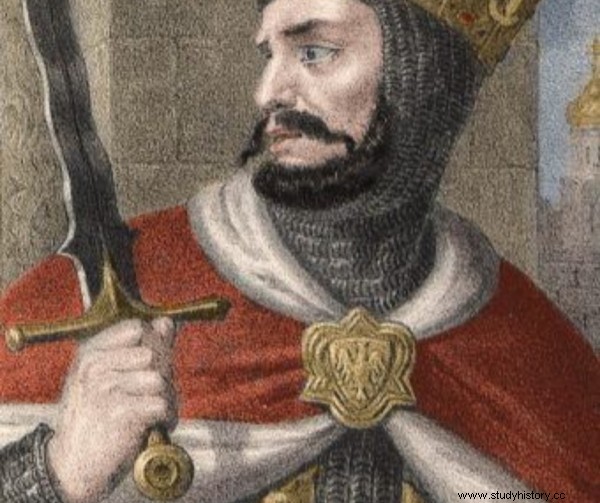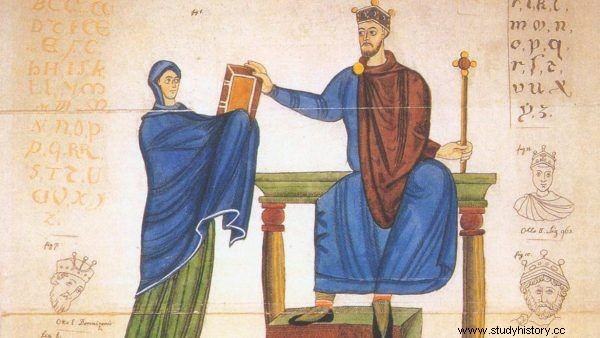People transported like cattle, men with crushed testicles, women - raped daily. Subjects deprived of arms, hands and tongues. Unrepentant Rulers:with their eye sockets burnt out. Sadism? Not. This is Poland.
Violence accompanied the rulers of the Piast dynasty from the very beginning:violence against external and internal enemies, against family and relatives, against their own and strangers. Creating a strong state out of nothing, subjugating neighboring tribes, suppressing the opposition and maintaining power, and finally introducing Christianity and extensive external conquests required determination and brutality in action.

From the very beginning of his reign, Bolesław the Brave showed ruthlessness and cruelty. The illustration shows a nineteenth-century image of the ruler. Coloring:Rafał Kuzak.
The means for this was violence:aggression, murder, torture, mutilation. Were the first Piasts, the founders of the Polish state and its founding fathers, in fact ruthless torturers and sadists? Was the state of Polans built on the blood and bones of enemies of the Piast princes? Here is a brief overview of early Piast violence. Note, text only for readers with strong nerves!
Blood Union
The ancestors of Mieszko I and Bolesław Chrobry - Lestek and Siemomysł - at the beginning of the 10th century and in the following years made an attempt to build a centralized state in which their family would play a major role. To this end, they forced subsequent tribes, families and settlements to recognize their authority, pay tribute and render services. As he emphasizes in his latest, shocking book The Rise of Power. All the conquests of Bolesław the Brave Michael Morys-Twarowski:
When they refused, [Lestek] visited them with fire and sword, burned the castles, took their inhabitants captive and sold them to Jewish merchants who paid silver dirhams. The unfortunates set off on a long journey. Often men were castrated and women raped .

The Piasts had no mercy for their enemies. They plundered and burned their castles to the ground, and made slaves of them themselves, which they later sold with great profit.
Let us add that the slave trade was a lucrative business for the Piast princes. Thus, in order to create a new state structure, in the 40s of the 10th century, the Piasts mercilessly destroyed local tribal settlements in Wielkopolska, murdered their elites, and sold the population into slavery or resettled them. Traces of these burnt settlements are found today by archaeologists.
The scale of the Piast success - but also the Piast brutality - is evidenced by the fact that only ashes remained of the tribe living on the Obra River. History has remembered neither the names of their chiefs nor even the name of their tribe - said Kamil Janicki in his Iron Ladies . Those who survived were displaced and forced to work on building new, powerful Piast castles in Poznań, Gniezno, Giecz or Bnin. This was how slave labor was used then.
Sadist in power
The son of Siemomysł, Mieszko I, also did not avoid violence. The most important event of his reign was undoubtedly the adoption of Christianity. This decision, breaking with the known and accepted for centuries religious order, had to provoke opposition from people attached to old customs. The prince, on the other hand, did not hesitate to use force to persuade those who refused to accept the new order, and at the same time to liquidate the opposition and competitors. Many of them suffered a bloody death at the hands of the impetuous ruler or his teammates.
Undoubtedly, Mieszko was a brutal and ruthless ruler, the master of the life and death of his subjects (Kamil Janicki even describes him as a "sadist"). He conquered other Polish lands with fire and iron. He burned the castle and razed it to the ground, and in other places he built his own, more powerful ones. Most likely, he also bloodily got rid of his close (perhaps some brothers) and distant relatives who could compete with his position.
We can guess that they were brutally eliminated:murdered or drastically mutilated during torture. Undoubtedly, Mieszko continued the practice of his ancestors, consisting in selling his subjects into slavery. Slaves were still the main export commodity of the Piast state. Mieszko was rushing his living goods to Prague, and luxury items and raw materials were wandered the other way - writes Kamil Janicki.
Blind or castrate
Bolesław Chrobry, his father's inherent son, a true master of political (and not only political) brutality, was not afraid to use violence. Contrary to the hagiographic image that Gall Anonim created for him in his chronicle (the ruler of virtuous, noble, generous and wonderful ), Chrobry was brutal, violent and ruthless. Violence was a constant and normal mode of action. Well, such were the times, such were the rulers. After all, the 10th century is the Iron Age , age of brutality and violence as the well-known medievalist and biographer of the Brave, prof. Jerzy Strzelczyk.

The image of the noble Brave from the chronicle of Gallus Anonymus has little to do with reality. In fact, it was brutal and violent. The illustration shows the nineteenth-century image of the first Polish king.
Bolesław began his reign with a strong accent:he expelled the widow of Mieszko I, Oda, and her three sons, and his half-brothers:Mieszko, Lambert and Świętopełek. In turn, two advisers who supported Oda - Odylena and Przybywoj - ordered to be blinded. Let us give the floor to Michael Morys-Twarowski, author of the book "The Birth of Power. All the conquests of Bolesław the Brave " :
Drabys of Bolesław chained disloyal advisors, locked them in a small room, and then gouged out their eyes with a knife. Perhaps it is the prince himself who is administering justice to them? Not for sadistic pleasure, but to fulfill a bloody duty…
Blinding was a frequently used form of torture and mutilation of opponents in those "iron" times. Another - equally popular - was castration.
With a nail or a knife
Chrobry turned out to be a much more zealous promoter of Christianity than his father. For Mieszko, accepting faith in one God was to a large extent a calculated political act. For Brave, from a child brought up in true Christian faith, strengthening it became a life imperative.

For Mieszko, baptism was only a political necessity. Chrobry treated the new faith much more seriously and brutally punished those who did not follow its principles. The illustration shows the 18th-century baptism of Mieszko I.
It was during his reign that the true Christianization of Poland began. The prince realized it in his own brutal way. This is what the German chronicler Thietmar wrote:
If any of these people dares to seduce someone else's wife or to engage in debauchery, he is immediately punished by the following:they lead him to the market bridge and fasten him to it by hammering a nail through the scrotum with nuclei. Then a knife is placed next to him and left with a difficult choice:either die there or cut off that part of the body .
On the other hand, those who did not observe the fast were punished with breaking their teeth. The law of God, newly introduced in this country, acquires greater force through such compulsion than through fasting instituted by the bishops. They are there like this that other customs, much worse than those that are neither pleasing to God nor to the natives, bring anything but fear Thietmar was saying. So ruling by fear was the best way to keep people obeyed.
Brave rapist
Chrobry had no mercy towards his political opponents. When Bolesław III the Red, enthroned by him on the Czech throne, conducted a bloody crackdown with the opposition, the terrified Czechs turned to the Polish ruler for an intervention.
The prince invited Rudy to Krakow, arrested him there and ordered him to be blinded, and then imprisoned him in one of the towns. This is how Michael Morys-Twarowski describes it in his book, "The Birth of Power" that has just been published:
The Czech prince came with only a few people. Cousins [Chrobry and Rudy were related] they got drunk as in good times, and at night Brave's men fell into the chamber of the distinguished guest, gouged out his eyes and imprisoned him. Also, to pacify the rebelling Czech nobles, Chrobry did not hesitate to use violence and torture. The method was simple:reward some, blind others or hang them.
In 1018, Chrobry made another intervention to Kiev, supporting one of the candidates for the local throne. After conquering the city, he became passionate about the sister of the deposed ruler of Kiev, Jarosław the Wise, Przedsław. When she denied him her favor, he simply raped her.

After capturing Kiev in 1018, the Brave raped and then kidnapped Przedsława, the sister of the local ruler, Jarosław the Wise. The picture shows a painting by Wincenty Smokowski.
Reliable Thietmar wrote:[one of Jarosław's sisters] once he had chosen himself, this old harlot Bolesław had abducted shamelessly, forgetting about his wedding wife . According to Gall, the rape of Przedsławawa and making her a one-time concubine was supposed to be an act of revenge against Jarosław, who previously did not want to give his sister Bolesław.
Mildness has not paid off
After Brave's death, his son Mieszko II took over power in Poland. He was quickly crowned and continued his father's expansionist policy. Like his father in the past, he also banished two of his brothers from the country - potential competitors to the throne. The older Bezprym went to Rus, the younger Otto to Germany. They were both lucky because they might have been killed, blinded, or castrated. This time, however, the kindness (or indecisiveness) of Mieszko II took revenge on him.
Bezprym assembled a Ruthenian-German coalition which attacked Poland from two sides. The deposed Mieszko had to flee, and Bezprym took power. The exiled king went to Bohemia, to the local prince Udalryk. There he was hit by the sins of the past from the Piasts:Udalryk imprisoned Mieszko and castrated as part of his revenge for Bolesław the Red's blindness by the Brave years ago ...

Mieszko II was definitely less predatory than his ancestors. It didn't do him any good.
We are among the Piasts…
Meanwhile, Bezprym ruled in Poland. As befits a real Piast, with his strength he based his power on violence:he subjected Mieszko's supporters to bloody persecution. Many gave the throat, many fled to save their lives. He murdered not only opponents but also their families. He had almost all of his brother's important henchmen killed.
The ruler's cruelty was so great that they turned against him ... his own subjects. As recorded in 1032 in the Hildesheim Yearbook Bezprym was murdered "by someone around him." And the murder was supposed to be inspired by his brothers. Well, as it is among the Piasts ...
